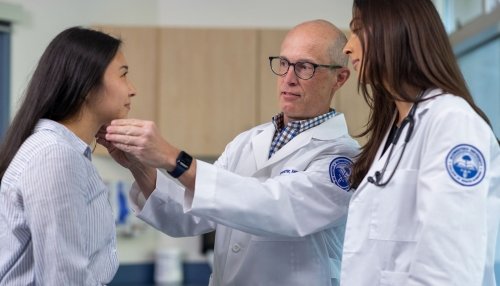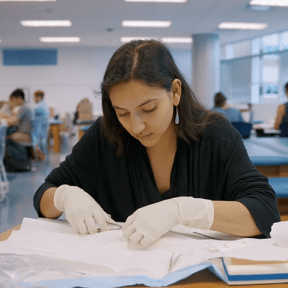Midwestern University's Master of Medical Science (M.M.S.) in Physician Assistant Studies is an immersive, full-time program spanning 27 months from matriculation to graduation. It offers students the opportunity to earn a valuable graduate degree while satisfying the eligibility requirements for the Physician Assistant National Certifying Examination (PANCE).
Interprofessional Focus
The Physician Assistant Program places a strong emphasis on interprofessional collaboration. As future healthcare providers, our students are encouraged to work seamlessly within multidisciplinary teams, fostering a holistic approach to patient care.
Curriculum Highlights
The comprehensive curriculum encompasses 12 months of in-depth basic science coursework, covering critical subjects such as anatomy, biochemistry, neuroscience, physiology, pharmacology, immunology, genetics, and microbiology. It also includes clinical coursework in clinical medicine, clinical reasoning and medical decision making, professional issues, and the interpretation of medical literature. In the subsequent 15 months, students participate in rotations in eight core clinical areas and one elective clinical setting. This period also includes advanced clinical medicine courses and culminates with a capstone project, providing a well-rounded education in physician assistant studies.
Clinical Experience
The second-year clinical experience takes place in Chicago and surrounding areas, offering diverse practice opportunities. Clinical settings range from ambulatory practices to hospitals, community health centers, and more, reflecting various geographic and demographic contexts. The program does utilize core site rotations in Illinois outside of the greater Chicagoland area. Housing at these sites is provided by the university for a nominal fee. Students must arrange their own housing and transportation for local and elective rotations. Midwestern University Physician Assistant students are never required to provide or solicit clinical sites or preceptors.
Ready for Practice
Upon graduation, Physician Assistant Program students possess the skills to embark on diverse career paths, confidently conducting patient assessments, interpreting diagnostic studies, selecting treatment modalities, managing emergencies, promoting health through education, and demonstrating essential interpersonal skills.
Learn More
Learn more about the requirements and find quick links to relevant catalog content to guide you in your application process.
- Bachelor's degree from a regionally accredited college or university
- Minimum cumulative and science GPA of 3.00 on a 4.00 scale
- Successful completion of prerequisite coursework from regionally accredited colleges or universities
- A minimum of 500 hours of direct patient care experience are required at the time of application submission
*Subject to change
Admissions Procedures
The Physician Assistant (PA) program adheres to a specific admission process, and prospective students are encouraged to become acquainted with our interview and selection procedures.
Advanced Placement
Midwestern University's PA Program does not permit advanced placement for prior academic, clinical, or life experience. Requests may be made for advanced placement for coursework and will only be considered if a letter grade of "C" or better has been earned and must be deemed equivalent to the Midwestern University course.
Extended Program
The PA Program does not offer an extended course of study beyond the usual length of the program.
PA Program Student Work Policy
To optimize success in our program, students are strongly discouraged from pursuing external employment while attending Midwestern University. We maintain a non-negotiable stance on managing workload, whether in the didactic or clinical phase, for those who choose external employment.
View catalog for more information*
*Subject to change
The Physician Assistant program in Downers Grove, IL, has established articulation agreements with select institutions. For detailed information and eligibility criteria, please refer to the full articulation agreements.
- Articulation Agreement with Elmhurst University: Beginning with the class matriculating in Fall 2025, the PA Program agrees to guarantee interviews for all qualified Elmhurst University applicants.
- Articulation Agreement with Aurora University: Beginning with the class matriculating in Fall 2023, Midwestern University’s participating colleges/programs agree to guarantee interviews for qualified Aurora University applicants.
- Articulation Agreement with Greenville University: Qualified students will receive an interview for Midwestern University programs.
- PA IL - CGS Biomedical Sciences Articulation Agreement: Qualified graduates of the Biomedical Sciences programs in the College of Graduate Studies (CGS) are guaranteed an interview for the Physician Assistant program in Downers Grove, IL under our Admissions Agreement.
Note: Students must meet all application deadlines for the professional program of interest. A guaranteed interview does not guarantee admission into the professional program.
The MWU CHS Physician Assistant Program reserves the right to alter its curriculum however and whenever it deems appropriate.
Total Quarter Credits in the Professional Program: 146
View PA Curriculum in the catalog*
*Subject to change
Core Competencies for the Midwestern University – Downers Grove Physician Assistant Program
To ensure students who graduate from the Midwestern University-Downers Grove Physician Assistant (PA) Program are prepared for entry-level PA practice, they receive a didactic and clinical training curriculum that facilitates their achievement of specific core competencies. The Midwestern University-Downers Grove PA Program competencies were developed using existing competency frameworks, such as the Competencies for the Physician Assistant Profession (revised 2020) and the Physician Assistant Education Association’s Core Competencies for New Physician Assistant Graduates. The core competencies adopted by the Midwestern University-Downers Grove PA Program are listed below.
1. Knowledge for Practice
Graduates should be able to recognize normal health states and emerging, acute, and chronic abnormal health states, utilizing current scientific evidence to inform clinical reasoning and medical decision-making, and apply this knowledge to patient care.
1.1: Demonstrate critical thinking in clinical situations
1.2: Access and interpret current and credible sources of medical information
1.3: Discern between acute, chronic, and emergent disease states
1.4: Incorporate principles of basic and clinical sciences to develop a differential diagnosis
1.5: Apply principles of basic and clinical sciences to accurately diagnose disease and formulate an appropriate treatment plan
2. Patient Centered-Practice
Graduates should provide patient-centered care that is evidence-based and focused on safety and health equity.
2.1: Gather accurate and essential information about patients through history-taking, physical examination, and diagnostic testing
2.2: Develop individualized patient management plans
2.3: Demonstrate proficiency in the performance of program-defined core clinical skills needed for entry-level practice
2.4: Refer patients appropriately
2.5: Provide care and education to patients to maintain and/or improve health
3. Interpersonal and Communication Skills
Graduates should demonstrate the ability to engage with patients and a variety of health care professionals in a manner that optimizes safe and effective patient-centered care.
3.1: Communicate effectively with patients
3.2: Demonstrate active listening and appropriate nonverbal communication with patients
3.3: Accurately document medical information in patient records
4. Professionalism
Graduates should demonstrate a commitment to practicing medicine in ethically and legally appropriate ways, emphasizing professional maturity by prioritizing the interest of those being served above one’s own interests, and recognizing personal limitations to ensure the delivery of safe and quality care.
4.1: Demonstrate compassion and respect for others
4.2: Demonstrate responsiveness to patient needs
4.3: Demonstrate provision of ethical care: Informed Consent
5. Practice-based Learning and Improvement/Personal Wellness
Graduates should be able to demonstrate a commitment to continuous self-improvement and patient care by critically assessing new medical information and addressing opportunities for growth in their medical abilities. They should also look for ways to maintain or improve on their overall health.
5.1: Exhibit self-awareness to identify strengths, address deficiencies, and recognize limits in knowledge
5.2: Create improvement goals that address gaps in knowledge, skills, and attitudes
5.3: Identify self-care and personal issues that affect one’s ability to fulfill professional responsibilities
The mission of the Midwestern University Physician Assistant (PA) Program is to develop competent, compassionate and professional physician assistants who will make a positive impact on their patients, community and the PA profession.
The MWU PA Program values the unique life experiences and perspectives each student contributes to our program. We believe cultural humility improves patient outcomes, and we are committed to ensuring our students are well-equipped to provide patient-centered care to all of the populations they may serve. Health equity and education on health care disparities are integrated into the Program curriculum to prepare students to serve diverse populations and address the health care needs of all patients.
Goals
The goals of the Midwestern University Physician Assistant Program are to:
- Recruit, matriculate and retain highly qualified students.
- Provide a comprehensive and evidence-based curriculum that prepares graduates for entry-level practice.
- Foster a culture of service and provide students and faculty with opportunities to engage with their communities and the medically underserved.
*The MWU IL PA program revised their program goals in February of 2024. Documentation of success in meeting the program's new goals will be published summer of 2025.
The Midwestern University PA Program demonstrates achievement of these goals by analyzing the results of student performance in the didactic and clinical year, PA National Certifying Exam (PANCE) pass rates, and regular surveys of graduates and preceptors.
National Certifying Exam (PANCE) Pass Rate 5-Year Average (2020-2024)
- Five Year First Time Test Taker Average Pass Rate for Program: 96%
Physician Assistant National Certifying Examination, Exam Performance Summary Report (PDF)
For information pertaining to the Program's attrition and graduation rates, please review the ARC-PA Student Attrition Template.
ARC-PA Student Attrition Template (PDF)
The average graduation rate for the program is 96%, which was calculated using the graduation rates for the PA Classes of 2022, 2023, and 2024.
- Female: 81%
- Male: 19%
- Mean Age: 23 years (Range 19-33)
- Mean Overall GPA: 3.84
- Mean Science GPA: 3.83
- Class Size: 86
- Top Home States: Illinois (41; 48%), Arizona (4), Michigan (8), Wisconsin (6)
- Facebook - @mwupaprogram
- Instagram - @mwupaprogram
The Accreditation Review Commission on Education for the Physician Assistant (ARC-PA) has granted Accreditation-Continued to the Midwestern University-Downers Grove Physician Assistant Program sponsored by Midwestern University. Accreditation-Continued is an accreditation status granted when a currently accredited program is in compliance with the ARC-PA Standards.
Accreditation remains in effect until the program closes or withdraws from the accreditation process or until accreditation is withdrawn for failure to comply with the Standards. The program’s accreditation history can be viewed on the ARC-PA website.
Midwestern University is accredited by The Higher Learning Commission/A Commission of the North Central Association of Colleges and Schools (HLC/NCA), 230 South LaSalle Street, Suite 7-500, Chicago, IL 60604-1413.
Academic Course Catalog
Explore details regarding your specific College/Program (subject to change).
Hear Our Stories
Marissa Barria, Physician Assistant Studies Program, College of Health Sciences, Glendale (Class of 2024)
“I think Midwestern has prepared me really well and our program does a really good job of working you towards the finish line.”
Erica Menocci, M.M.S., PA-C, Assistant Professor, College of Health Sciences, Physician Assistant Program, Downers Grove
"They're definitely gonna learn a wide variety of medicines so that they're prepared for entry level practice, when they're finished with the program."
Meghan Morrissette, College of Health Sciences-Downers Grove, Physician Assistant Program, Class of 2024
"It was inspiring to see so many dedicated people in one space all striving for a common goal for the benefit of others. I knew this community was something I wanted to be a part of me and my career.”

College Stats
Median Salary
$110,000 average median salary.
Exam Pass Rate
98% certifying exam pass rate.
Graduation Rate
96% graduation rate (3-year average).



